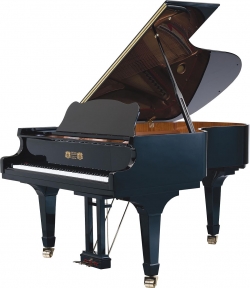Romeo and Juliet are having a baby boy. They are trying to guess who the baby will look like. Romeo has brown eyes and black hair. Juliet has blue eyes, and blonde hair. Will their son look like his mom or his dad? Will he look like both of them? Maybe he won't look like either of them!
No two people are exactly alike. Our bodies have many different parts, and each part is built in a different way. As your body grows, it needs directions to tell all of these parts how to grow. Picture your body as a library full of books. Each book in the library has instructions for a different body part. There is a book for eye color, a book for nose shape, a book for hair color, a book for ear shape and so on. Scientists call each one of these books a gene. Every person has almost 25,000 genes. This means that your library has 25,000 books of directions for your body.

I'm going to need to find some smaller books.
Genes make us look the way we do. Most people look like their parents because they get their genes from their parents. Each of our parents have their own set of genes, or library of directions that make them look the way they do. When two people have a child, the child gets half of each parent's genes. The dad's sperm joins up with the mother's egg to makes a new person!
Just as we got our genes from our parents, they got theirs from their parents. Genes are passed down through families from grandparents to parents to children.
Inherit means to have something given to you by your parents. Our genes are given to us by our parents, which means that we inherited them from our parents. When your mom decides to give you her piano, you have inherited the piano from her. However, even though she gave you that piano, you might not play it like she plays it. In the same way, having your parents' genes does not mean you look completely like them.

Sure it's nice, but I have no idea how to play it.
Piano Industry Pro, CC BY-SA 3.0 , via Wikimedia Commons
Like a book with two chapters, each of our genes has two parts, or two sets of directions. Parents pass one set of directions from each of their genes on to their children. Picture your mom and dad each holding a book with two chapters. The pages of your mom's book are red and your dad's are blue. Your mom and dad each rip their book in half and give one chapter to you. You put the two together and you now have a book with one red and one blue chapter. The two parts of a gene are called
alleles. Every one of your genes has one allele from your mom's genes and one from your dad's; they mix together and make a new and different book of instructions that tell how to make you.
Body parts can come out looking different ways. That's why each gene has two sets of directions. Remember how Romeo has brown eyes while Juliet has blue eyes? That means that Juliet has a book with a set of directions, or alleles, for making blue eyes and Romeo has a book with a set of alleles for making brown eyes. However, each of those books has two sets of directions; there are two alleles in each gene. Some people might have a book for eye color with two sets of brown directions, and some might have a book with two sets of blue directions. Others might have a book with one brown set of directions and one blue set of directions.
People with an eye color gene that has two brown alleles will always have brown eyes. The same is true for two blue alleles. However, we also have people with two different alleles, or sets of directions in their eye color gene. What color does that make their eyes? If Romeo and Juliet each give their son one allele from each gene, he will have directions for brown eyes and blue eyes. Which eye color will he have? How will his body know what color to make his eyes?
The simple answer is that some alleles, or chapters of directions, are stronger than others. When a baby duck hatches, the first thing it sees is its mom. From that point on it will only follow her. If the baby duck's dad comes around, the baby duck will still only follow its mom. Our bodies are the same way. We will read and follow the strongest set of directions. When one set of directions is stronger than the other it is called a
dominant allele.

OK everyone, follow me.
David Menke, Public domain, via Wikimedia Commons
Do our bodies ever follow the weaker set of directions? They won't if the stronger set is there. It's just like the mom and dad duck with their baby. The daddy duck may really want his baby to follow him, but the baby will only follow its mom because it saw her first. What happens, though, if one of the chapters in a book is not stronger than the other? What if the stronger allele isn't there? If the mother duck was not there when the baby duck was born and it saw its dad first, would it follow its dad? Yes! Sometimes a book can have two weak chapters in it. If a gene has two weak alleles one is not stronger than the other. The body will read and then follow the weaker set of directions. The weaker set of directions is called a
recessive allele.
Most of the way we look is based on which genes, or chapters, we have, and which are strong and which are weak. That is why people look so different. It all depends on which directions you have and how they mix together. Romeo has brown eyes, which come from stronger alleles than Juliet's blue eyes. He has black hair, which comes from stronger alleles than blonde hair. However, the genes for his attached ear lobes are weaker than Juliet's genes for her free ear lobes. Their son will most likely have Romeo's eyes and hair, but Juliet's ears.
Here are some more sets of stronger and weaker directions:
- Brown eyes are stronger than green eyes and blue eyes.
- Green eyes are stronger than blue.
- Having a pointed hairline is stronger than having a straight hairline.
- Being able to curl your tongue is stronger than not being able to.
- Being able to bend your thumb backwards is weaker than having a straight thumb.
- Having a cleft or split chin is weaker than having a smooth chin.
We can only guess what Romeo and Juliet's son will look like based on the stronger and weaker chapters in their books of directions. In truth, the way we look is not that simple. It takes many different genes all acting together to make a body look the way it does. There might be five different books that have directions for your nose. Romeo and Juliet's son could have either one of his parent's nose or, a mix of each, or it could be completely different. He might even have his great Uncle Melvin's crooked nose. It all depends on what sets of directions he gets, how they mix together, and which ones are weak or strong.